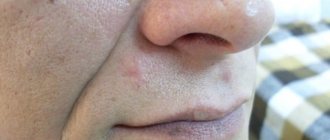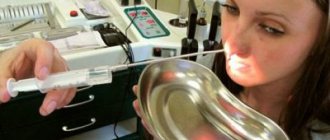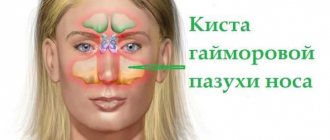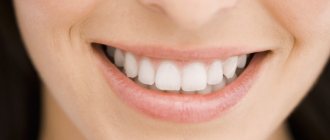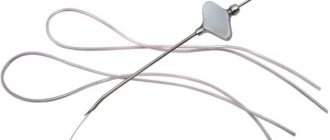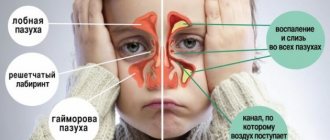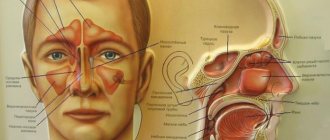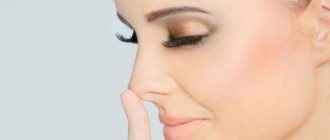Endoscopic shaver cystectomy - surgery to remove a maxillary sinus cyst
Endoscopic shaver cystectomy has proven to be an effective and safe operation.
The endoscopic method minimizes trauma to tissues and organs without requiring skin dissection. Thanks to the endoscope camera (which is inserted through a puncture of the maxillary sinus), the image is displayed on the monitor, and the doctor carries out all the necessary manipulations.
The operation lasts from 30 minutes to 1 hour. Performed under local anesthesia or general anesthesia.
After the cyst is removed, there are no scars or scars left. This is another advantage of this operation.
What is a maxillary sinus cyst?
A maxillary sinus cyst is a benign formation consisting of a thin-walled mucous membrane filled with fluid.
Causes of cysts in the sinuses:
- The mucous membrane lining the paranasal sinuses, including the maxillary sinus, contains glands that produce secretion (mucus). If the excretory duct of a gland stops functioning, the gland becomes filled with secretion and, gradually stretching, turns into a thin-walled spherical formation - a cyst, filling part of the sinus.
Provoking factors for the formation of cysts in the sinuses:
- changes in the hormonal background of the sinus mucosa;
- allergic reactions;
- inflammatory processes in the roots of the teeth of the upper jaw;
- acute and chronic diseases of the nasal cavity;
- injuries leading to facial asymmetry;
- polyps;
- abnormal structure of the nasal septum.
Varieties
Patients experience different types of maxillary sinus cysts.
There are two main types of this pathology:
- Retention or true. A retention cyst in the maxillary sinuses is surrounded by dense tissue and forms anywhere in the sinus from mucous tissue.
- Odontogenic or false. Most often, an odontogenic cyst begins to form in the maxillary sinus. The growth is formed not by the mucous membrane, but from the gum tissue. Unlike a true neoplasm, a false one is surrounded by a thin single-layer capsule.
It is no secret that neoplasms can appear only in individual sinuses. Therefore, depending on the location, the following types of cysts can be distinguished:
- Cyst of the right maxillary sinus. If the tumor appears in the right maxillary sinus, the patient should notice heavy discharge from the right nostril.
- Cyst of the left maxillary sinus. When such a growth appears, patients complain of worsening nasal breathing, congestion in the left nostril and the release of a large amount of thick mucus from it.
Types of surgery
There are several types of operations that are used to remove cystic formations. Most often, endoscopic surgery and gentle opening of the upper jaw through the anterior wall are prescribed.
| Type of operation | Advantages and disadvantages | How is the operation performed? |
| Endoscopic intervention | The main advantage is the low invasiveness of the operation, and dangerous complications rarely occur. The disadvantage is that not all cysts can be removed endoscopically. | The procedure does not require anesthesia. No incisions are made on the skin; instead, a special device is inserted into the nasal cavity through a natural opening, and then a special device is inserted into the sinus and the cyst is removed. |
| Opening through the front wall | The main advantage is the ability to remove large formations. Disadvantages include high morbidity and the need to use anesthesia. | Access to the sinus is gained through an incision in the anterior wall of the sinus. The cystic formation is removed, and if necessary, the anastomosis is expanded. |
Dangerous consequences
The earlier a maxillary sinus cyst is detected and its treatment is started, the lower the risk of complications. The most common of them is inflammation and suppuration of the contents of the capsule. Under the pressure of accumulated pus, the cyst shell may burst. The infection and the toxins it produces contaminate the surrounding tissues; there is a possibility of their penetration into other organs with the development of inflammatory processes. Also, a burst cyst can provoke an exacerbation of chronic diseases. The large size of the tumor prevents the unhindered entry of air into the nasal cavity during inhalation and removal during exhalation. This leads to a decrease in the supply of oxygen to the blood and an increase in the concentration of carbon dioxide in the body's cells. Oxygen starvation negatively affects the functioning of all organs, especially the brain. This condition is most dangerous for a growing fetus during intrauterine development. Also, by blocking the penetration of air into the respiratory tract, the cyst threatens the appearance of apnea - interruption of breathing during sleep. By squeezing the tissues of the visual analyzer, the neoplasm causes disturbances in the visual perception of the surrounding world, for example, diplopia. The tumor also has adverse effects on the bones of the skull - under the pressure of its contents they can become deformed, inflammation contributes to tissue necrosis, and in some cases they are rejected.
Folk remedies
Some people prefer to use folk remedies to treat cystic sinusitis. Before you start treating sinusitis and cysts, you need to familiarize yourself with effective folk methods.
Burdock
Sometimes treatment with folk remedies is carried out using burdock. To prepare the medicine, two burdock leaves are enough. They are passed through a meat grinder or ground in a blender. Then they are transferred to a small jar and placed in the refrigerator. The prepared gruel should be used three times daily. During each dose, you should eat one spoonful of the medicine.
Aloe juice
To get rid of a cyst and reduce the threat of its appearance, you can drip aloe juice. To prepare the solution, 150 ml of juice is mixed with 250 ml of warm water. The prepared mixture is instilled every day, 2 drops into each nostril.
Diagnostics
Before you begin to treat cystic sinusitis, it is necessary to conduct a diagnosis to confirm the diagnosis. A cyst of the left maxillary sinus and right maxillary sinus can be diagnosed in various ways. Most often, the following procedures are carried out for this:
- X-ray. Quite often, this procedure is performed to identify malignant and benign tumors. An x-ray allows you to examine the cyst in detail and determine where it is located. Sometimes specialists take x-rays of the maxillary sinuses with contrast. This method allows you to identify even small growths.
- Puncture. To confirm cystic sinusitis, a puncture is performed, during which the growth in the nasal cavity is punctured. The diagnosis will be confirmed if, after piercing, yellowish mucus begins to flow from the nose.
- CT scan. This type of diagnosis is the most reliable. Using computed tomography, you can confirm cancer, the presence of a growth in the cavity and study its structure in detail.
- Magnetic resonance imaging. MRI allows you to take very precise pictures of the nasal cavity for careful study. This procedure allows you to detect even microscopic tumors. Therefore, with its help, cystic sinusitis can be detected at the initial stage of its development.
Non-operative treatment methods
For maxillary sinus cysts, treatment without surgery using conservative therapy methods is aimed at eliminating inflammatory processes in the nasal and oral cavities. For these purposes, rinsing the nasal passages with saline solution (Marimer, Aquamaris), administering a drug that improves the outflow of mucus (Sinusforte), and corticosteroid-based products (Beconase) are used. Traditional treatment methods involve the use of vasoconstrictor sprays (Tizina, Rhinosalina). Prescribing antibiotics helps to destroy an infection that has spread beyond the cyst if its shell has burst. Isofra and Bioparox are used as topical agents; Azithromycin and Lincomycin act systemically on the body. Under their influence, the cyst can resolve on its own. Pain and fever can be relieved by taking Aspirin or Paracetamol. Irritation of the mucous membrane is successfully treated with antihistamines (Suprastin, Euris), its restoration is facilitated by Morenasal. An odontogenic cyst in the maxillary sinus can resolve on its own after sanitation of the oral cavity with the elimination of all inflammatory diseases of the teeth and gums. Lidaza has a destructive effect on the membrane and contents of the tumor. For large volumes of the cystic sac, the fluid accumulated inside it can be removed by puncture - puncture with a needle and pumping out using a special instrument.
Traditional medicine tips
Healers have developed many recommendations for reducing the size of cysts using folk remedies. They can relieve inflammation, and in some cases, prevent the development of sinusitis, but in order for the cyst to completely resolve or be surgically removed, it is necessary to seek help from a medical facility. When using folk recipes, you should remember that it is strictly forbidden to warm up the nasal sinuses, do steam inhalations, or use essential oils in rinsing solutions. Also, you cannot use medicinal plants and honey if the body is prone to allergic manifestations. The following folk remedies provide a good effect for cystic neoplasms of the maxillary sinuses:
- Drops from the juice of the leaves of the golden mustache plant. Place 3 drops into your nose in the morning and evening.
- A mixture of mumiyo (2 g), glycerin (1 tsp) and water (1 tbsp). The method of application and dosage are the same as the previous recipe.
- Squeeze the juice from forest cyclamen tubers, mix with water in a ratio of 1 to 4. Place 1-2 drops in your nose in the morning for a week.
- Onion-honey mixture for rinsing the nasal cavity. Mix the finely chopped onion with honey dissolved in boiled and then cooled water (½ tsp per 100 ml). Let it brew for 5 hours, strain, apply morning and evening.
When these methods of conservative treatment are used together, the cyst may disappear, but there is no complete guarantee that after some time it will not appear again. A radical method of eliminating a tumor is removal during surgery. The least traumatic and highly effective operation using an endoscope.
Rehabilitation
The postoperative period is no less important than the surgical intervention itself. A cyst in the maxillary sinus and sinus lifting lead to an increased risk of developing an infectious process, so the patient is prescribed an intensive course of antibacterial therapy. Every day, for a week after sinus lifting, you should rinse your mouth with an antiseptic solution (preferably after each meal).
During the first time after surgery it is prohibited:
- Brush your teeth with a stiff toothbrush;
- Consume hot or cold foods, as well as excessively sour or spicy foods;
- Drink liquids through a straw;
- Smoking;
- Perform physical activity;
- Stay in the sun for a long time;
- Take blood thinning medications.
Oral care is of paramount importance in preventing the development of an infectious process. After each meal, patients gently (using a cotton swab) clean the wound surface. But under no circumstances should you rub it. The teeth are cleaned with a soft toothbrush, after which the mouth is rinsed with an antiseptic.
!Important: For a situation where a cyst in the maxillary sinus is caused by inflammation from a tooth, probably the main thing is to eliminate the cause of the formation of the cyst; in this situation, this cause is the tooth. There is no point in re-treating canals and crazy spending on microscopists and various doctors making promises that will not come true. It often happens that re-treatment of canals to correct a cyst takes six months, costs a lot of money and is carried out without a guarantee. However, this preserved inflammation outside the tooth can become aggravated at any time, and this is acceptable even after two retreatments with an interval of a year. Also, we must take into account that the most interesting thing is not the operation of tooth extraction, but the fact that the removal should be carried out by a specialized maxillofacial or ENT surgeon, otherwise there is a risk of the cyst breaking off at the border with the maxillary sinus, and this calls into question any reconstructive surgery . Implantation and sinus lifting cannot be performed until the areas of bone compromised by infection are 100 percent restored.
Clinical manifestations (symptoms) of maxillary sinus cysts
The cyst may not manifest itself in any way and may be discovered completely by chance during radiographic examinations performed for other purposes. In some cases, a maxillary sinus cyst manifests itself as clear complaints that force the patient to consult an ENT doctor.
Symptoms of a cyst in the sinus:
- pain in the upper jaw, often spreading to the orbit and temple on the side of the affected sinus;
- headache;
- nasal congestion, mainly on the painful side;
- recurrent inflammatory diseases of the maxillary sinus.
Verification (checking) of the diagnosis of “cyst in the sinus” is carried out based on the results of X-ray and computed tomography (CT) examination of the paranasal sinuses.
